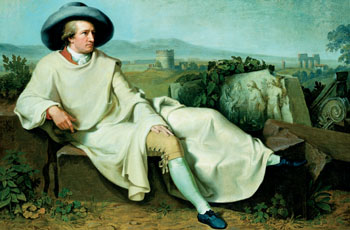Weimar, a German town with strong European traditions, hosted the 4th European QCD network meeting on 12-15 September 2001.

Financed by the European Union, the research network “Quantum Chromodynamics at High Energies and the Deep Structure of Elementary Particles” supports the collaboration of quantum chromodynamics (QCD) theorists from eight European countries interested in fundamental aspects of QCD and its applications in experiments at accelerator laboratories. Following meetings in Durham (the home institute of network spokesperson James Stirling), Florence and Paris, Germany hosted the meeting in 2001.
Around 70 participants from Europe, the US and Russia presented and discussed recent results on QCD. A large number of presentations by young researchers showed how active the field is. Robert Klanner, research director of Hamburg’s DESY laboratory, opened the meeting with an outline of prospects for DESY’s upgraded HERA II collider, which started up in 2001. HERA II sees a factor of five increase in luminosity over the original collider. Klanner also reported on preparations for the future TESLA linear collider, which will lead to new challenges in QCD research.
HERA results on deep inelastic electron-proton scattering have always been a focus of the network’s interest. In particular, measurements of proton structure functions in the region of small momentum fraction (Bjorken-x) are crucial for the precise determination of parton densities, which will be necessary for understanding processes to be studied at CERN’s forthcoming Large Hadron Collider (LHC). In the small-Bjorken-x region, unravelling the interplay of effects arising from Balitsky, Fadin, Kuraev and Lipatov (BFKL) theory for radiative corrections to parton scattering, and the QCD evolution equations of Dokshitzer, Gribov, Lipatov, Altarelli and Parisi (DGLAP), is a challenge to theorists. As Guido Altarelli pointed out, a resumption of large logarithmic corrections improves the accuracy and can extend the region of validity of the evolution equations.
Further developments
QCD also plays an important role in electron-positron scattering. One example is the search for the perturbative QCD pomeron that emerges from BFKL theory as being responsible for effects observed in small-angle collisions. Electron-positron scattering is the best environment to search for a BFKL pomeron, since photons radiated by the electron and positron provide the cleanest incoming states for hadronic processes. If both photons are highly virtual, perturbative QCD allows an absolute prediction for the total two-photon cross-section. Comparisons of leading-order BFKL calculations with data from CERN’s LEP electron-positron collider have been made. These leave no doubt that a consistent next-to-leading-order calculation is needed, both for the BFKL pomeron and for the photon impact factor. Whereas the former has been completed, the latter is still under investigation, and two independent groups reported results.
For hadron colliders, researchers are working hard to develop reliable and efficient event-generator programs. As Bryan Webber of Cambridge University emphasized, the Monte Carlo simulation of multijet final states will be a vital tool in the search for new physics at the LHC. The development of these computer algorithms moves particle physicists back into the front line of modern computing.
Higher-order corrections
Another branch of contemporary QCD-related research is the calculation of higher-order corrections to hard processes. With HERA giving high statistics data on proton structure functions, theorists have started extending the accuracy of analytical QCD calculations up to three loops. These ambitious calculations require new techniques and tools to be designed to allow the calculation of higher-order Feynman diagrams to be computerized as completely as possible.
The investigation of the transition in QCD from perturbative to nonperturbative physics is likely to remain a point of interest for the next few years.
The most challenging question in QCD is the transition from perturbative QCD to nonperturbative high-energy scattering. In deep-inelastic scattering, HERA has measured the transition from QCD parton physics at large momentum transfer to photoproduction at zero momentum transfer, and theorists are trying to analyse the onset of nonperturbative effects. An intriguing possibility is the existence of a novel state of QCD – saturation – characterized by high gluon density. Phenomenological support for this comes from a model based on this idea that has been very successful in describing HERA data in the transition region. An alternative, more conservative approach starts from the nonperturbative side where the photoproduction cross-section is consistent with the hadronic pomeron, and introduces a second “hard” pomeron to account for the observed stronger rise with energy at large momentum transfer. The investigation of the transition in QCD from perturbative to nonperturbative physics is likely to remain a point of interest for the next few years.
Weimar is a focal point for German and European history and culture; Germany’s greatest poet and dramatist, Johann Wolfgang von Goethe lived there for more than 40 years. Friedrich von Schiller also settled there,and collaborated with Goethe to make the Weimar Theatre one of the most prestigious in the country. The composer Franz Liszt and the philosopher Friedrich Nietzsche are also among the town’s celebrated residents. Weimar has witnessed more than its fair share of historic events, such as the battle of Jena and Auerstedt and the meeting of Napoleon and Tsar Alexander I in nearby Erfurt. It lent its name to the Weimar Republic from 1919 until 1933, and it gave birth to the world famous Bauhaus style of architecture. It is for this unique combination of reasons that meeting organizers, Jochen Bartels and Johannes Blümlein, chose Weimar for the European QCD network meeting. Following extensive renovations for Goethe’s 250th anniversary in 1999, the town offered a pleasant and stimulating atmosphere for scientific discussions.








